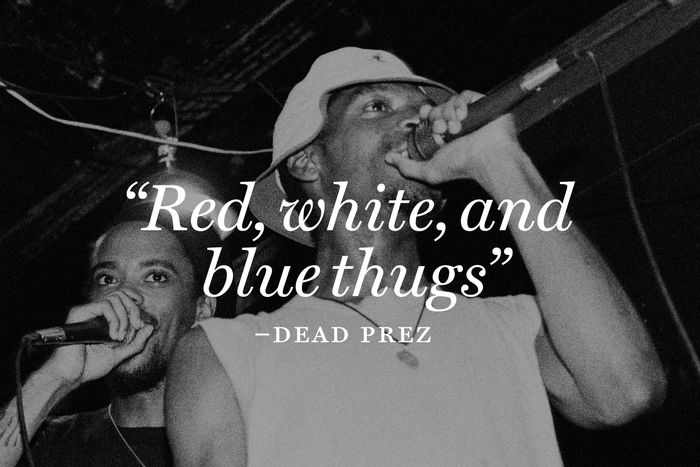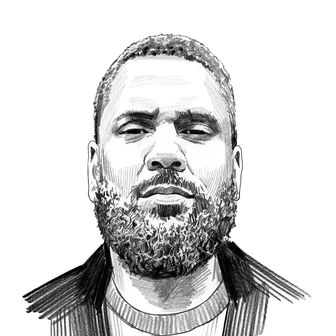
The year after the Twin Towers fell, P. Diddy stood in front of Madison Square Garden wearing a Yankees cap and matching letterman jacket. “We still here!” he barked defiantly. “And we building four more new towers!” The Harlem rap mogul was appearing in the music video for Jermaine Dupri’s “Welcome to Atlanta” remix, which featured Diddy on a verse celebrating his hometown. It was mostly clichés — “If you can make it here, you can make it anywhere!” — but his nod to September 11 marked something new.
Ever since Al Qaeda operatives crashed two hijacked airplanes into the World Trade Center, a patriotic fervor had gripped the country. The destruction of those buildings was taken personally, an affront to everything that made people in the United States good and free. Diddy bought into the hype, reassuring his audience that the insult wounded him, too, and that his allegiance to the towers’ symbolism was the same as theirs.
Dead Prez felt no such loyalty. Not long after Diddy’s proclamation, the Brooklyn-based rap duo made their stance plain on a 2002 track called “Know Your Enemy.” “Know your enemy, know yourself / That’s the politic / George Bush is way worse than bin Laden is.” The emcees M-1 and stic.man described the FBI and CIA as “the real terrorists” and took mocking aim at “red, white, and blue thugs” — a striking contrast to how other musical groups responded to the attacks. (The Strokes removed the track “New York City Cops” from their 2001 debut album for fear it would offend the police.) The rap duo’s musical output between 2000 and 2004 would serve as a bracing soundtrack to the early Bush era. But their acid skepticism of the post-9/11 nationalistic spectacle was rooted in an older period.
Like M-1 and stic.man, hip-hop culture was born during the death throes of the Black Power movement in the 1970s. Emcees spoke candidly about life in New York’s postindustrial ghettos, but if the opportunity arose, it was easier to get out and get paid than dismantle those ghettos. By the turn of the century, most hip-hop was pop music — less the “CNN of Black America,” as Chuck D had termed it, than its Bravo, a showcase for those who most ostentatiously embraced the dominant culture’s ideals of success.
Dead Prez criticized this turn relentlessly. Their most famous record, the 2000 single “Hip-Hop,” indicted the music industry for exploiting Black artists and broadcasting messages that undermined Black liberation. Freedom was not an ephemeral concept to them, nor was it an individual pursuit. The problems facing Black people boiled down to capitalism, imperialism, and white supremacy. They had an answer: a Pan-Africanist socialist revolution.
But for all their criticism of the state of hip-hop, Dead Prez never thought of themselves as outsiders. They saw their aesthetic as somewhere between N.W.A and Public Enemy: a liberation project expressed using the popular conventions of gangsta rap. In the hands of M-1 and stic, that genre’s enthusiasm for guns, murder, and robbery was recast as righteous politics. Black survival was criminal in America. To survive was to commit crime. The single “Hell Yeah (Pimp the System)” from their second album, 2004’s RBG: revolutionary but gangsta, was a vivid play-by-play of how to get over “ ’til we get our freedom,” from robbing pizza-delivery boys to pulling credit-card scams.
This was plainly the music of the young — struck through with the kind of unyielding moral certainty that softens with age. (M-1 is now almost 50 and has five children; stic co-owns a lifestyle brand and is passionate about “Fit Hop,” a genre of exercise-themed rap that he created.) But the group’s refusal to identify with the vision of America that the Bush administration urged people to unite behind hasn’t lost its salience. “Suicide planes falling like bombs from out the sky,” raps stic on “Know Your Enemy.” “They wasn’t aiming at us / Not at my house / They hit the World Trade, the Pentagon, and almost got the White House / Now everybody walking ’round patriotic / How we gon’ fight to keep freedom when we ain’t got it?”
Whatever popularity Dead Prez might have sacrificed for being so militant they made up for by earning cachet among famous aficionados. Kanye West described himself in 2013 as a cross of M-1, stic, and Steve Jobs. Another champion was comedian Dave Chappelle, who featured them in his 2006 documentary Block Party. The instrumental for “Hip-Hop” was his walk-on music on Chappelle’s Show.
Still, between Diddy and Bush on one side and Dead Prez on the other, we could have predicted which vision would win out. The World Trade Center is indeed back. I remember a past life working there, visiting a brand-new office before they had even brought in the furniture. It’s not four towers, but a single enormous one — hundreds of feet taller than the original set.
Looking out over the city from the highest floors of its tallest building and knowing its peculiar history, you get the clear sense that you’re standing inside a giant middle finger. No matter how many towers they knock down — “they” being Osama bin Laden and his followers, but truly, “they” could be anyone — America can always go bigger and badder. We’re supposed to interpret this as triumph.
But another memory eclipses that one. We are 20 years old and driving from Los Angeles to San Francisco, where Dead Prez is playing a show. We walk streets choked with blunt smoke. We climb the bar stairs to a packed room where M-1 and stic hold court. They tell us that Black people won’t get free without revolution. They tell us that “terrorism” is a political term applied most often by those doing the terrorizing. They tell us that sooner or later empires decay in a stew of their own hubris. And I ask myself which memory, 20 years after 9/11, explains America more honestly.
More on 9/11: 20 years later
- Where the Meaning of Flight 93 Can Never End
- The Great Maritime Rescue of Lower Manhattan on 9/11
- The Woman in White






























